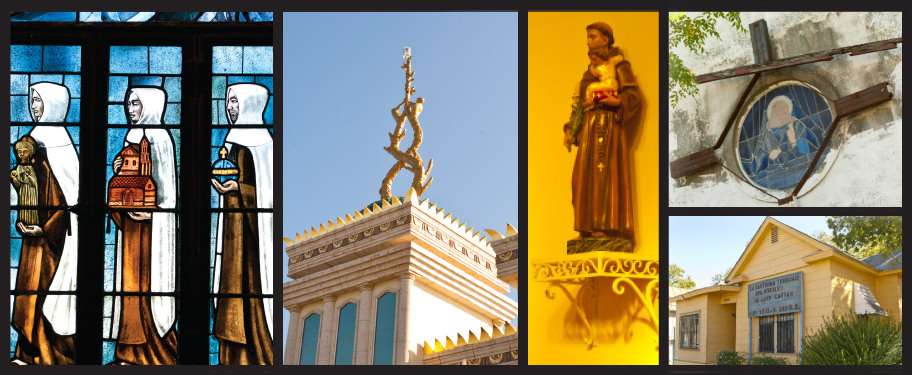



Places of worship, often called sacred, are the heartbeats of the communities that surround them. And these sacred places aren’t simply the ones with golden spires that sprout above treetops. They’re often small nuggets nestled quietly in the most surprising places, as one UTSA architecture class discovered.
The roar of traffic on Zarzamora Street doesn’t penetrate the stone walls of the Basilica of the National Shrine of The Little Flower. Inside the dark and cool church, built in 1931, there’s a smell of polished wood. Congregants sit spaced apart, heads bent in prayer. This place, sitting on the city’s West Side, is sacred.
Not far away, off Buena Vista Street, is La Santisima Trinidad, a small, slightly worn wooden house built in 1936 that also serves as a church. It, too, is sacred.
They couldn’t be more different, yet they’re both among the more than 200 sites in a 12-mile area defined as sacred and considered to be cultural assets by UTSA’s Center for Cultural Sustainability.
In spring 2011, a graduate architecture class teamed up with the national nonprofit and nonsectarian Partners for Sacred Places to identify areas that could be considered sacred. The class was a historic preservation seminar led by local architect Charles John and was part of the Graduate Certificate Program in Historic Preservation. Using the national organization’s definition of that word—any location that is or has been dedicated for the worship of any religion—the class identified churches, synagogues, convents and cemeteries located within the Westside Development Corporation, which is bounded by Interstate 35, Interstate 10/U.S. 90 West, Acme Road/36th Street and Cincinnati Avenue.
"If it appeared to be sacred to the people there, it went on our list," said Vincent Ramirez, a second-semester graduate student in architecture. "Sometimes we’d find places behind houses, even revival tents. We also included abandoned churches. It didn’t have to be old—sometimes they would be brand new. We didn’t exclude anything."
For four weeks, the students divided into groups and trolled the area. It was surprisingly grueling.
"We didn’t spare any road," Ramirez said. Even dirt roads and alleyways were explored. "It’s like you’re stepping into a different world. There were chickens running everywhere and you’d be surprised. You’d look up to find a little church sitting between two houses."
Intrigued by the students’ findings, William Dupont, director of the Center for Cultural Sustainability and the San Antonio Conservation Society Endowed Professor in the College of Architecture, decided to take it further. What if there was a scientific way to show their cultural value? He tapped Ramirez to continue the research by documenting each site’s location and construction date, as well as the programs it offered, the size of its congregation and its proximity to schools and restaurants.
Using digital geographic software, also called GIS, what resulted was about two dozen maps that showed the area’s pulse, Ramirez said.
"It gives it a heartbeat, like Bam-Bam. There are this many people here at this location at this time of the week," Ramirez said. "This is a lower-income neighborhood. There is so much cultural richness in it that people often overlook in these neighborhoods."
Findings documented in an academic paper will eventually be published by Dupont and Ramirez and used to secure grant funding for further study.
"This is an area that has to be explored," Dupont said. "The city is going to keep growing in population and size, yet there are attributes about it that everybody loves. How do we grow yet retain our continuity with our past? I think it’s valuable for the community to understand what is important about itself and its cultural heritage and seek some cultural continuity."
Places of worship have always driven communities. San Antonio is just one example, Ramirez said.
"Look at the Alamo. It was once a chapel and then a community grew out of it," he said. "Then you have the missions south of downtown. Those are still live congregations. It seems like churches come first and the neighborhoods build around them. They’re important."
–Lety Laurel